#Home Automation in Pittsburgh
Explore tagged Tumblr posts
Text
Advantages of Home Automation in Pittsburgh Homes

Are you someone who envisions a home where lights dim at your command, security is seamless, and your favorite tunes play as you step through the door? If so, you might be considering home automation, a futuristic concept that’s becoming increasingly prevalent in modern households. In Pittsburgh, the demand for smart homes is rising, and modern technologies and advancements are fueling this trend.
Curious to know how top-tier service providers specializing in home automation in Pittsburgh can transform your lifestyle and the myriad benefits awaiting you through this revolutionary facility? Continue reading!
Here are some of the advantages you can experience:
Enhanced Convenience
Imagine controlling your entire home through a single interface - whether it is adjusting the thermostat, turning off lights, or locking doors. Home automation systems centralize control, simplifying daily tasks and adding a layer of convenience to your life. With just a few taps on your smartphone or a voice command, managing various household elements becomes effortless.
Improved Energy Efficiency
Smart homes excel at optimizing energy consumption. Automated thermostats learn your preferences and adjust temperatures accordingly, saving energy and reducing utility bills. Additionally, smart lighting systems ensure lights are only on when needed, minimizing unnecessary electricity usage.
Heightened Security
According to a recent survey, a significant number of new homeowners express concerns regarding the safety and security of their property. Specifically, 59% of respondents cite worries about potential home break-ins. In this case, the monitoring equipment installed by the best security cameras installer in Pittsburgh helps you enjoy your vacation or trip happily. Additionally, home automation offers advanced security features like smart locks, motion-activated cameras, and real-time monitoring. Receive instant alerts on your phone if there’s suspicious activity, allowing you to take immediate action from anywhere.
Customized Comfort
You can tailor settings to match your preferences - setting specific temperatures for different times of the day and creating lighting scenes for various occasions. You can also ask your home theater installer to program it to your liking. It is all about creating an environment that suits your lifestyle.
Remote Access
One of the most significant advantages of home automation is the ability to control your home even when you’re away. Whether you’re at work or traveling, remote access lets you monitor your house, adjust settings, and ensure everything is in order through your smartphone or computer.
Increased Property Value
Integrating home automation into your residence not only enhances your lifestyle but also amplifies its market value. Automated features serve as a compelling selling point should you choose to list your property, given the rising interest among buyers in smart homes.
Savings in the Long Run
While the initial setup cost might seem significant, home automation can lead to substantial savings over time. Energy-efficient systems reduce utility bills, and automated appliances often have a longer lifespan due to optimized usage, cutting down on replacement and maintenance costs.
Wrap Up
Whether you are drawn to the idea of effortless control or seeking to increase your property’s value, the advantages of home automation speak volumes in shaping the future of modern living. Having gained insight into the advantages of home automation, the next step is selecting the finest service providers for home automation in Pittsburgh. Our recommendation is Red Spark Technology! Renowned for their expertise in data cabling installation, network cabling installation, home automation, and security camera installation in the Pittsburgh area, they stand out as an excellent choice.
Source: https://medium.com/@redsparktechnology/advantages-of-home-automation-in-pittsburgh-homes-8fe9815ca916
0 notes
Text

march 15 v devils, 7-3 win
nice.
i really enjoyed geno's bizarro over-the-top penalty fugue state he went into for this one. almost like he was glitching out...
we can call this a homage to @sevenfists' wonderful tragic hockeybot geno, but not as good because like...duh.
this does contain a homophobic slur just fyi.
Evgeni has followed a fairly strict game-day protocol ever since he woke up in Pittsburgh almost 20 years ago. The details have changed, refinements and efficiencies added in as his software was upgraded, but the basics, the stuff that keeps him running at optimal performance and giving his all on the ice, have remained the same.
Most of his start-up process is automated now, thankfully. Those first couple of years he needed to be manually disconnected from his charging station and powered on every morning, and since the station was bulky and he had to charge upright all night he’d spend the first half-hour trying to loosen up his joints and walk without a hitch in his step. It also meant he had to stay at the rink—the unit was permanently installed in his maintenance room, and they only had one more extraordinarily bulky one that got lugged around for road trips. Evgeni spent a lot of mornings after Dana woke him up wandering the hallways until the rest of the guys started to trickle in.
He came back from the Olympics in Sochi with a new charging port, discreetly installed under his left armpit and USB-C compatible provided it’s connected to one of his new, portable power packs. The automated start-up patch came through shortly after, and all he had to do was program in a power-down and power-up time and he boots up all on his own.
Powering down in a comfortable position had been a revelation. Being able to do it wherever he wanted was another.
Evgeni considered buying his own house—the idea of his own space is appealing, even if he’s not quite sure what people do at home by themselves at night. He’d run a pro/con analysis, though, and asked someone to look over the results to verify the conclusion he came to: however unlikely it may be, the scenario of something going wrong when nobody is there to find Evgeni and perform emergency maintenance is an unacceptable trade-off for home ownership.
Sidney’s suggestion that Evgeni just move in with him was much more logical.
Something else that came with Evgeni’s 2014 upgrade was an unexpected, but not unwelcome, libido add-on. All part of the goal to make Evgeni and others like him more human, integrate them more into society at large. It took a few months for Evgeni to calibrate to his new desires; he’d expected a standard program, especially with his lab of origin located in Russia, but after a while he figured out he was gay.
He spent the off-season experimenting and arrived in Pittsburgh for the season with a list of likes and dislikes, and a type. Sidney almost exactly matched the latter, and based on Evgeni’s new experience he was confident that the first two items could be adjusted to suit.
He’d been right.
Sidney has said he’s in love with Evgeni. Evgeni’s emotional response center has been upgraded on a regular basis over the years, but most of the time it seems like he’s a little…slow, maybe, or removed from how he should be feeling, such as it is.
Not about Sidney. He’s pretty sure he loves Sidney too.
Sidney also understands the value of a routine. He has his own, more rigidly engrained than anything Evgeni does on gameday, and he’s more than happy to leave Evgeni alone to boot up and run his diagnostics in peace. It’s unsettling to watch, Evgeni’s been told—his eyes go disconcertingly blank, and for a solid five minutes he’s utterly unresponsive. People get weird about it, even if they’ve seen it before. He prefers to be alone.
Mid-March in a season like this one is a grind. Evgeni’s been in for repairs more this season than the last two combined, and they might not be officially eliminated from playoff contention yet but it’s just a matter of time; motivation is hard to come by, even for Evgeni. It’s reassuring to fall into his programming and run through each system one by one, making sure he’s primed for optimal performance.
There’s a spark in the corner of his vision.
Evgeni pauses, scrolls back through lines of code, reviews. Nothing. He must have imagined it.
When he pulls himself out, he’s running a few minutes late; Sidney will be almost done with his breakfast.
Evgeni heaves himself to his feet and heads downstairs. Sidney drives on game days, so Evgeni downloads the Devils’ five most recent games to review in the car.
—
He shouldn’t need to, but Evgeni likes to top-up his charge while Sidney takes his pre-game nap. Sidney likes it too, says it feels like they’re falling asleep together; it also helps that once Evgeni’s powered down he doesn’t move, so once they’re arranged to maximize Sidney’s comfort there’s no mid-sleep jostling.
When Evgeni boots back up, he feels…weird. Wrong, lying in bed with Sidney wrapped around him like normal.
He unplugs his charger and extracts himself as carefully as he can, putting on his suit and making his way downstairs to wait until Sidney is awake and ready to drive them to the rink for the game.
Sidney frowns at him when he finally comes down, but Evgeni turns his head, and Sidney lets him be.
They make small talk in the car like usual, but Evgeni’s distracted, and eventually Sidney goes quiet. To distract himself Evgeni runs back to his source code, a well-worn self-soothing mechanism when he’s feeling jumpy or off.
The code itself is simple but effective, wrapped inside a descriptor of the reason Evgeni was made in the first place.
The modern sport of ice hockey was developed in Canada…
By the time the game starts Evgeni’s restless, shifting from foot to foot during the anthem and eyeing the opposing team with more hostility than he’s used to experiencing.
Evgeni’s never pretended to be the cleanest player in the league. He’s sneaky with his stick, takes risky penalties because when guys hit back he doesn’t feel pain like humans do, and sometimes it works. Even for him, though, this game is tough sledding.
When his reckless double minor results in a goal against and lets the Devils draw within one, Evgeni shatters his stick in the box, then glides back to the bench with his mouth twisted in a frown. He feels—he wants to hit something, or maybe someone.
His higher processing is on alert at this aberration in behavior, but all Evgeni can do is sit on the bench, accept his new stick, and wait.
“G,” comes Sidney’s voice in his ear, and Evgeni flinches away violently—what is Sidney doing, sitting so close? Why is he pressing their legs together like that? Why is he reaching for Evgeni’s hand where it’s resting on his thigh? “Hey, you okay? You seem a little rattled; do you need a breather, maybe someone to check you out?”
“Fuck off, what you do,” Evgeni hisses, snatching his hand away. “Don’t touch me, like, what are you, a faggot? Back off.”
Crosby freezes, and Letang peers around from his other side, eyes narrowed. “What the fuck did you just say to him?”
“You fuck off too,” Evgeni snaps, half-rising with his fists clenching in his gloves, and suddenly the bot maintenance guy has an iron grip on his arm.
“Cool it, or I’m taking you back and decommissioning you here and now instead of letting you get through this game and get examined,” Freddy snaps in his ear.
Evgeni shakes his head. There’s an odd echo in his ears, metallic and hollow, and snippets from his source code keep floating into his brain—Hockey Canada announced a plan to address "systemic issues" in the culture of hockey; the early history of hockey encouraged physical intimidation and control; oh, the good old hockey game....
The rest of the game is a blur. Evgeni doesn’t cause any more goals against, even manages to put up a primary assist on the power play, but he spends his time on the bench spacing out, shrinking away from anyone who tries to talk to him as he scrolls through his coding.
The diagnostics are all still fine. Something’s wrong, though.
Evgeni spent a year in stasis while his system was flooded with hockey history and hockey culture. He doesn’t remember it very well, but those first few years had aligned pretty well with what he’d learned—hockey was rough, hockey was physical, hockey was insular and conservative and macho.
Times change. So did Evgeni, through programming and his own conclusions drawn from observing the world around him.
He seesaws between past and present, software upgrades and personality patches warring in his motherboard until he thinks he might short out. He doesn’t, obviously; there are enough redundancies built into him to keep the ISS in orbit, let alone one android on an ice rink, but that doesn’t stop him from feeling overheated and dazed by the time they troop off the ice.
Instead of walking to the locker room he turns left, toward the bot maintenance room.
He half-hears a whispered argument behind him, and shortly after it cuts off someone hurries to catch up.
“Hey,” Sidney says, and Evgeni cringes, his words from earlier rattling in his skull like they were said by someone else.
“Sorry,” he grits out. He wants to reach out and take Sidney’s hand, but the thought of someone seeing him holding hands with a man fills him with nausea. “Not sure…”
“Yeah,” Sidney says. His voice is even, flat and unsettling, but Evgeni doesn’t have room to work through that and find a fix.
Freddy’s waiting outside the room with his arms crossed. He relaxes when Evgeni rounds into view, raising his eyebrows but not commenting when Sidney follows them into the room.
“Alright, let’s get you opened up and see what’s going on,” Freddy says, gesturing to the maintenance station.
It looks like a torture chamber, a metal chair surrounded by needles and machinery and a large, ominous machine with a screen and dozens of blinking lights. Evgeni gingerly lowers himself into the seat and closes his eyes, flinching a little when the chair lifts and tilts him forward, giving Freddy access to his control panel.
It doesn’t hurt to have his panel opened, but it feels wrong, invasive and intrusive. Evgeni used to need to get strapped into the chair to stop from fighting, but now he squeezes his eyes closed and bites on his tongue and takes some of the big, soothing breaths that do nothing for the functioning of his shell but seem to settle his mind anyway.
“Fuck,” Freddy murmurs, and Evgeni’s eyes fly open. Before he can say a word, Sidney’s at his side.
“What is it?” Sidney demands, resting a hand on Evgeni’s shoulder and rubbing his thumb soothingly as he leans over to peer into the panel. “Oh, shit.”
“What!” Evgeni demands, clenching his fists. He hates this, hates feeling helpless and paralyzed while people bend over his back and stare down into his innards.
“Not sure what happened in here, bud, but you’ve got some seriously fucked-up wires. Something in here burnt out, and a few of the metal casings are fried.” Freddy touches something inside Evgeni that sends his left knee straight out in a kick. “Yeah, damn, that’s no good. You were maybe a few days from catching on fire.”
Sidney’s hand spasms on Evgeni’s shoulder. “Can you fix him?” he asks, voice low and worried.
“Oh, sure,” Freddy says, and the easy confidence in his voice is reassuring. Freddy never sounds overwhelmed, never sounds like there’s something he can’t make work. “Might take a while, I think I’ll have to boot him into safety mode for a few hours to make sure everything’s connected okay, but he should be ready to go by Tuesday’s game.”
Sidney’s exhale is shaky with relief. Evgeni wants to reach up and touch his hand. “We start now?” he says instead, keeping his eyes on the ground.
“Sure thing. When was your last backup?” Freddy asks, rummaging through his toolkit. “Sid, when you head back can you let Sully know what’s going on, tell him I’ll get everyone a full rundown once I can pull the readout?”
“Sure. And he backed up last night, so you can probably just—”
Evgeni interrupts him. “No,” he says firmly, finally gathering the courage to crane his neck and look up at Sidney’s face. “Back up now, please. Want to remember what I say.”
“Good man,” Freddy says, clapping Evgeni on his other shoulder.
Sidney crouches down so he can look Evgeni in the eye. “You didn’t mean it,” he says quietly. His eyebrows are furrowed, and there’s a frown tugging at his mouth. He’s sad, Evgeni concludes, and hurt, and he’s trying to hide it. “I mean, it’s like…you’re hurt, you pulled something out from your coding, it’s not—”
“Sid,” Evgeni interrupts, and Sidney startles. A quirk in Evgeni’s programming is that he doesn’t use nicknames unless he really makes an effort. “Doesn’t matter why, I still say. Can’t forget I do, it’s not…” He thinks, running through the relationships course he downloaded back in 2015 when the team was struggling and Sidney seemed like he was on the verge of ending things. “It’s reason, not excuse. I still need, like, accountability.”
He mangles the word, but Sidney’s small smile is worth it.
—
Evgeni doesn’t dream, exactly. When he’s powered down there’s still a flicker of awareness as long as he has battery, enough to pull himself to wakefulness if there’s a threat, but extended downtime for repairs is like floating in a thick black cloud. There’s a very distance perception of voices, of movement and hands on his shell and wires being replaced, but nothing that Evgeni can actually truly call a memory as opposed to a superimposed expectation of what happened.
The grogginess when he’s powered back on is very real, though, as is the stiffness in his knees. He hopes he’ll have enough time to loosen up before he has to play.
“Welcome back,” Freddy’s cheerful voice booms, and Evgeni winces. “You should be set. Had you walk and sit and do a few jumping jacks yesterday in safety mode, nothing else loosened up or shorted. Okay—hands?”
He walks Evgeni through the post-repairs protocol, checking his reactivity, his senses, the last things he remembers to check his backup loaded correctly. Check, check, check.
When Evgeni stumbles out of the room, blinking against the harsh overhead lights in the hall, Sidney’s waiting for him.
“Hey,” Sidney says, eyes flickering over Evgeni’s face.
“I’m so sorry,” Evgeni says immediately. The shame that rolls through him is new and unexpectedly powerful—he rarely feels embarrassed, his programming doesn’t allow for him to make choices that lead to that. When it’s working correctly, of course. “God, Sidney, you know I don’t mean.”
“I know,” Sidney says, and the caution in his voice makes Evgeni’s chest ache. “I told Kris what happened, he said he won’t kick your ass unless it happens again.”
“I let him,” Evgeni says earnestly, which makes Sidney laugh. “Promise, I stand there, he kick and scratch and do whatever, I just let.”
He reaches forward tentatively, touching his fingers to the back of Sidney’s hand. The flood of relief when Sidney turns his hand up and laces their fingers together is nearly enough to make him lose his balance.
Emotions are tricky things, Evgeni thinks, but he wouldn’t wipe them for the world.
52 notes
·
View notes
Text
Smart Home Trends in Pittsburgh: Transforming Pittsburgh Smart Homes in 2025
The rise of technology has revolutionized the way we live, and smart home trends in Pittsburgh are no exception. Homeowners in the Steel City are increasingly embracing innovations that make daily living more convenient, secure, and energy-efficient. Whether you’re upgrading your current home or investing in a new one, understanding the latest trends can help you create a modern, connected space that suits Pittsburgh’s unique lifestyle.
Smart Thermostats Pittsburgh: Energy Efficiency Meets Comfort
One of the most popular smart home devices gaining traction in Pittsburgh is the smart thermostat. These devices allow homeowners to control heating and cooling systems remotely via smartphone apps. In a city with varying seasonal temperatures like Pittsburgh, a smart thermostat Pittsburgh can optimize energy usage by learning your schedule and adjusting temperatures automatically. This not only reduces utility bills but also ensures your home stays comfortable year-round.
Smart Lighting Pittsburgh: Bright Ideas for Modern Homes
Lighting is another area where Pittsburgh smart homes are seeing significant upgrades. Smart lighting Pittsburgh systems allow users to control lights through voice commands, apps, or automation schedules. Beyond convenience, these systems offer energy savings by turning lights off when rooms are unoccupied or adjusting brightness according to natural light levels. Additionally, smart lighting can enhance security by simulating occupancy when you’re away, deterring potential intruders.
Home Security Pittsburgh: Keeping Your Property Safe
Security remains a top priority for Pittsburgh homeowners investing in smart home technology. Advanced home security Pittsburgh systems now include smart locks, doorbell cameras, motion sensors, and 24/7 monitoring services that can be accessed remotely. These systems provide peace of mind by allowing you to check on your property anytime and receive instant alerts about suspicious activity. Integration with other smart devices further strengthens your home’s defenses and offers a seamless user experience.
Pittsburgh Smart Homes: The Future Is Here
The convergence of smart thermostats, lighting, and security is shaping the future of Pittsburgh smart homes. Homeowners are increasingly drawn to integrated systems that work together to enhance convenience, reduce energy consumption, and increase property value. As technology continues to evolve, smart homes in Pittsburgh are becoming more intuitive, accessible, and customizable to fit the needs of every family.
Final Thoughts
Whether you’re a tech enthusiast or a homeowner looking to improve comfort and safety, staying up-to-date with the latest smart home trends in Pittsburgh is key. Incorporating devices like smart thermostats, lighting, and security systems not only modernizes your home but also offers tangible benefits for energy savings and peace of mind. If you’re considering selling your Pittsburgh home, upgrading with smart technology can be a strong selling point in today’s market.
At Buys Houses, we’re here to help homeowners navigate the evolving Pittsburgh real estate landscape—whether you want to upgrade or sell. Contact us today to learn more about how smart home technology impacts your home’s value and appeal.
0 notes
Text
How To Fix Payment Chaos With NetSuite Integration
The platform’s NetSuite Integration helps you to make payments from a single interface.
Mike runs a custom T-shirt business out of Pittsburgh. He’s got five employees, three vendors who all want to be paid differently, and a growing list of online orders that need fulfillment by yesterday.

Like a lot of small business owners, Mike’s day starts with a to-do list and ends with a headache. And most of the time, that headache comes from one thing: managing payments.
He uses NetSuite for inventory and accounting—it works great. But cutting checks? Mailing them? Paying vendors by card? That’s where he kept hitting walls.
Until he found OnlineCheckWriter.com – Powered by Zil Money.
Integration Without the Hassle
Integration is simple and easy. No complicated setup. No switching back and forth. Just one seamless dashboard where he could manage everything—from cutting checks to sending wire transfers.
Printing Checks Became a 2-Minute Job
Mike ordered pre-printed checks. They were pricey, slow to arrive, and a pain when he ran out.
Now? With OnlineCheckWriter.com - Powered by Zil Money
He prints checks from his desk using plain white paper
He adds his logo, signature, and brand colors
And the checks look more professional than ever
He even saved up to 80% on check costs by skipping the pre-printed stuff entirely.
Mailing Checks? He Doesn’t Even Touch an Envelope
One of Mike’s vendors still wants a paper check by mail. No problem.
The all in one platform lets him mail checks straight from the office or home. He picks First Class USPS or even FedEx Overnight, and OnlineCheckWriter.com - Powered by Zil Money handles the printing, stuffing, and shipping.
All Mike has to do is click “Send.” Done.
When He Needs It Fast—eChecks Step In
Mike’s graphic designer prefers digital. With OnlineCheckWriter.com - Powered by Zil Money, Mike just emails an eCheck as a printable PDF.
It gets there instantly
The designer can print and deposit it
Mike can track it the whole way
No delays. No printing. Just easy.
The Game-Changer: Paying by Credit Card (Even When They Don’t Accept Cards)
Here’s where Mike really leveled up.
His fabric supplier doesn’t take cards—but Mike wanted to use his business credit card for points and cash flow flexibility.
The check printing software made it happen:
He pays with his credit card
The cloud-based software converts it into a check or ACH for the supplier
No merchant account needed, no extra charges for the vendor
He kept his credit line active, earned cashback, and didn’t have to ask, “Do you take Visa?”
ACH, Wires, and International Payments—All in One Place
Mike works with a few international artists for custom designs. With OnlineCheckWriter.com - Powered by Zil Money, he doesn’t have to hunt for another app.
The platform lets him:
Send ACH transfers for local vendors
Use wire transfers for international payments
Even create payment links for quick turnarounds
One dashboard. Every payment type. Zero headaches.
Invoicing + Payment Links = Getting Paid Faster
Mike also started using the platform’s invoicing features to bill his custom clients.
He sends branded invoices with secure payment links. Clients pay via card, ACH, or bank transfer—whatever’s easiest.
No chasing checks
No “lost in the mail” excuses
Just smooth, trackable payments
Security That Would Make Anyone Proud
Mike’s not a security expert—but OnlineCheckWriter.com - Powered by Zil Money takes care of that part for him.
The platform is:
PCI DSS compliant
Fully encrypted
Uses tokenization
Offers multi-factor authentication
And includes Positive Pay to block fake or altered checks
The API Integration That Makes Life Smoother
The cheek printing software’s API works to automate tons of tasks:
Scheduled check runs
Recurring vendor payments
Auto-generated invoices
White-label payment flows for partners
Mike doesn’t need to hire a dev team to make it work—it’s built for real business owners.
Mobile Access, Team Roles, and No-Nonsense Control
Mike’s team needed access too. OnlineCheckWriter.com - Powered by Zil Money lets him set role-based permissions, so his accountant can handle approvals while Mike focuses on orders.
He can access everything from:
His office desktop
His phone at a vendor meeting
Or his tablet from a weekend market
It’s cloud-based, secure, and ready when he is.
Conclsuion
Mike doesn’t spend hours on payments anymore. He doesn’t stress when a vendor asks for a check, or when payroll hits during a tight month.
The all in one platform gives him total control over how he sends, receives, and tracks money.
And he’s not alone—over a million users trust the platform for over $91 billion in payments. From custom shops to consultancies to local contractors, the platform is making payment headaches a thing of the past.
Try OnlineCheckWriter.com – Powered by Zil Money today. One platform. All the payment tools you need—without the mess.
0 notes
Text
Best Garage Door Installation in Pittsburgh, PA – A1A Garage Door Pittsburgh

A reliable and attractive garage door is more than just a finishing touch on your home or business — it’s a key component of security, efficiency, and curb appeal. In Pittsburgh, PA, where the seasons can be harsh and property values continue to climb, choosing the right garage door installation company is a critical decision. That’s why homeowners and commercial property owners across the region trust A1A Garage Door Pittsburgh for top-quality garage door installation services.
With a strong reputation built on experience, craftsmanship, and customer satisfaction, A1A Garage Door Pittsburgh stands out as one of the best choices in the area. From classic carriage-style doors to sleek modern designs, their expert installation team ensures that every job is done with precision, professionalism, and care.
Why Professional Garage Door Installation Matters
A garage door is one of the largest moving objects in your home. It operates multiple times a day and plays a crucial role in protecting your family, vehicles, and belongings. Poor installation can lead to safety hazards, energy loss, mechanical failure, and even property damage.
Professional installation ensures your door functions smoothly, seals tightly, and aligns perfectly. It also helps maximize the lifespan of the door and opener, reducing long-term maintenance and repair costs. That’s why turning to trusted professionals like those at A1A Garage Door Pittsburgh is essential.
What Sets A1A Garage Door Pittsburgh Apart?
When it comes to garage door installation, not all companies deliver the same level of service. A1A Garage Door Pittsburgh distinguishes itself through a combination of experience, quality, and customer focus that few can match.
1. Experienced and Certified Installers
The team at A1A consists of fully trained and certified technicians with years of experience in residential and commercial garage door installation. Whether it's a single-family home in a quiet suburb or a busy commercial property in the heart of the city, A1A handles every job with the same level of precision and professionalism.
Their installers are familiar with all major door brands, materials, and opener systems, ensuring the installation process is smooth, efficient, and customized to your needs.
2. Wide Range of High-Quality Garage Doors
A1A Garage Door Pittsburgh offers a diverse selection of garage doors in a variety of styles, materials, and finishes. Customers can choose from:
Steel garage doors – Durable, low-maintenance, and affordable
Wood garage doors – Classic charm with custom craftsmanship
Aluminum and glass doors – Sleek and modern for a contemporary look
Insulated garage doors – Energy-efficient and great for Pittsburgh’s seasonal changes
No matter your design preferences or budget, A1A helps you find a garage door that enhances your property’s appearance and function.
3. Energy Efficiency for Pittsburgh’s Climate
Pittsburgh experiences a full range of weather conditions, from freezing winters to humid summers. A1A Garage Door Pittsburgh ensures that every installation considers thermal insulation, weather sealing, and durability. Their high-R-value doors help maintain indoor comfort and reduce heating and cooling costs — a smart investment for energy-conscious homeowners.
4. Smart Garage Door Technology
Looking for a door that does more than just open and close? A1A offers the latest in smart garage door technology. From smartphone-controlled openers to integrated security cameras, they help homeowners enjoy convenience, safety, and peace of mind. Their team installs and configures systems that work seamlessly with today’s most popular home automation platforms.
5. Custom Solutions for Every Property
No two homes are exactly alike, and neither are their garage needs. A1A provides personalized consultations to assess your property and recommend the ideal garage door system. They consider everything — size, structure, design, insulation, and lifestyle — to ensure a perfect fit. Their commitment to custom solutions makes them a favorite among homeowners with unique architectural requirements.
6. Clean, Timely, and Professional Service
From start to finish, A1A Garage Door Pittsburgh delivers a hassle-free installation experience. They arrive on time, work efficiently, and maintain a clean work area. Once the installation is complete, they conduct a full inspection and walk you through the system’s operation and maintenance tips. Their goal isn’t just to install a door — it’s to leave every customer completely satisfied.
7. Trusted by Homeowners and Businesses Alike
A1A Garage Door Pittsburgh doesn’t just serve residential clients. They also provide top-tier installation services for commercial buildings, including warehouses, service centers, and retail facilities. Their commercial-grade doors are built to withstand heavy use and demanding conditions, offering security and functionality in one package.
Local Expertise You Can Count On
As a locally operated business, A1A Garage Door Pittsburgh understands the architectural styles and weather conditions unique to the Pittsburgh area. Their local knowledge helps ensure every garage door is installed with long-term performance in mind. And because they’re part of the community, they care deeply about their customers and reputation.
When you choose A1A, you're working with a company that combines national-level professionalism with small-business values.
Final Thoughts: The Best Garage Door Installation in Pittsburgh
Garage door installation isn’t just about hanging a door — it’s about improving your home’s safety, efficiency, and visual appeal. With so much riding on the quality of the work, there’s no room for compromise.
For Pittsburgh residents and business owners, A1A garage door installation in Pittsburgh PA offers the perfect combination of quality products, skilled installation, and dependable service. Their track record speaks for itself, and their customers consistently praise them for professionalism, responsiveness, and excellent results.
If you’re looking to upgrade your garage door or install one in a new property, trust the experts at A1A Garage Door Pittsburgh — where experience, craftsmanship, and customer satisfaction come standard.
#united states#usa#news#garage door installation in Pittsburgh PA#garage door installation#garage door#door installation in Pittsburgh PA
0 notes
Text
Artificial Intelligence (AI) is at the forefront of technological advancements, driving innovations across various sectors, from healthcare to finance and beyond. As AI continues to evolve, the demand for skilled professionals in this field is skyrocketing. For those looking to pursue a career in AI, selecting the right educational institution is crucial. Pennsylvania, with its rich academic heritage, offers several excellent universities and colleges with strong AI programs. This article will guide you through some of the best institutions in Pennsylvania for studying AI, helping you make an informed decision. 1. Carnegie Mellon University Overview Carnegie Mellon University (CMU) in Pittsburgh is arguably one of the most renowned institutions globally for AI and computer science. CMU has consistently ranked among the top universities worldwide in these fields. AI Programs Offered CMU’s School of Computer Science offers several AI-related programs: Bachelor of Science in Artificial Intelligence (BSAI): This program is one of the first undergraduate AI programs in the world, focusing on the core concepts of AI, including machine learning, neural networks, and robotics. Master of Science in Artificial Intelligence and Innovation (MSAII): This program is designed for students who want to take their AI expertise into the business world, focusing on real-world applications and entrepreneurial ventures. Ph.D. in Machine Learning: CMU’s Ph.D. program is highly respected, offering advanced research opportunities in AI and machine learning. Research Opportunities CMU is home to several research centers focused on AI, such as the Language Technologies Institute and the Robotics Institute. These centers provide students with ample opportunities to engage in cutting-edge research alongside leading experts in the field. Industry Connections CMU has strong ties with industry giants like Google, IBM, and Uber, providing students with internship and job opportunities that are unparalleled. Location and Campus Life Pittsburgh offers a vibrant urban environment with a rich cultural scene, making it an ideal place for students. The CMU campus itself is known for its collaborative atmosphere and state-of-the-art facilities. 2. University of Pennsylvania Overview The University of Pennsylvania (UPenn), an Ivy League institution located in Philadelphia, is another top contender for AI education in Pennsylvania. UPenn’s strong interdisciplinary approach integrates AI with other fields such as healthcare, business, and social sciences. AI Programs Offered UPenn offers several programs for students interested in AI: Bachelor’s Degree in Computer and Information Science: This program offers AI as a concentration, allowing students to delve into machine learning, natural language processing, and computer vision. Master of Science in Engineering in Data Science (MSE-DS): While not exclusively an AI program, this degree covers significant AI-related content, particularly in machine learning and data analytics. Ph.D. in Computer and Information Science: UPenn’s Ph.D. program offers AI as one of the key areas of research, supported by a world-class faculty. Research Opportunities UPenn’s GRASP Laboratory (General Robotics, Automation, Sensing & Perception) is one of the oldest and most prestigious AI research centers globally. Students can engage in research that spans robotics, perception, machine learning, and AI ethics. Industry Connections UPenn’s strategic location in Philadelphia and its strong alumni network provide excellent connections to industries in tech, finance, and healthcare, offering students numerous opportunities for internships and employment. Location and Campus Life Philadelphia is a historical city with a rich cultural heritage. UPenn’s campus is a blend of tradition and modernity, offering students a dynamic environment to study and grow. 3. Lehigh University
Overview Located in Bethlehem, Pennsylvania, Lehigh University is a smaller institution known for its strong engineering and computer science programs. Lehigh offers a personalized education experience with a focus on innovation and hands-on learning. AI Programs Offered Lehigh’s AI offerings include: Bachelor of Science in Computer Science and Engineering: This program offers AI and machine learning as elective courses, allowing students to build a solid foundation in these areas. Master of Science in Computer Science: This program offers courses in AI, machine learning, and data mining, with opportunities for research in AI-related fields. Research Opportunities Lehigh’s Institute for Data, Intelligent Systems, and Computation (I-DISC) provides research opportunities in AI, focusing on data-driven intelligent systems. Students can work on projects that span various industries, from healthcare to smart cities. Industry Connections Lehigh has strong connections with local industries and tech companies, offering students opportunities for internships and collaborative projects. The university’s career services are known for providing strong support in connecting students with potential employers. Location and Campus Life Bethlehem offers a quiet and scenic environment, with a close-knit community feel. Lehigh’s campus is picturesque, with a mix of historic and modern buildings, providing a conducive atmosphere for academic pursuits. 4. Drexel University Overview Drexel University, located in Philadelphia, is known for its co-operative education program, which integrates classroom learning with real-world experience. Drexel’s approach to AI education is practical and industry-focused. AI Programs Offered Drexel offers several programs related to AI: Bachelor’s Degree in Computer Science: Students can choose electives in AI and machine learning, gaining practical skills in these areas. Master of Science in Artificial Intelligence and Machine Learning: This program is designed for students who want to specialize in AI, covering topics such as deep learning, natural language processing, and AI ethics. Ph.D. in Computer Science: Drexel’s Ph.D. program offers AI as a key research area, with opportunities to work on innovative projects. Research Opportunities Drexel’s College of Computing & Informatics (CCI) is home to cutting-edge research in AI and machine learning. The university’s co-op program also allows students to gain hands-on experience in AI-related industries. Industry Connections Drexel’s co-op program is one of the largest in the U.S., with partnerships with over 1,500 employers, including leading tech companies. This gives students a unique opportunity to gain industry experience while studying. Location and Campus Life Drexel’s urban campus in Philadelphia offers students access to a wide range of cultural, social, and professional opportunities. The university is known for its diverse student body and strong emphasis on experiential learning. 5. Temple University Overview Temple University, also in Philadelphia, offers a strong computer science program with opportunities to specialize in AI. Temple is known for its diverse student population and commitment to research and innovation. AI Programs Offered Temple offers the following AI-related programs: Bachelor’s Degree in Computer Science: This program includes courses in AI, machine learning, and data science, preparing students for careers in these fields. Master of Science in Computer Science: This program offers a focus on AI, with courses in machine learning, natural language processing, and AI applications. Ph.D. in Computer Science: Temple’s Ph.D. program allows students to engage in advanced research in AI and related fields. Research Opportunities Temple’s Center for Data Analytics and Biomedical Informatics (DABI) is a hub for AI research, particularly in healthcare applications.
Students have the opportunity to work on interdisciplinary projects that have real-world impact. Industry Connections Temple’s location in Philadelphia offers students access to a wide range of industries, from healthcare to finance. The university’s strong career services help students connect with employers and secure internships. Location and Campus Life Temple’s urban campus is vibrant and diverse, offering students a dynamic environment for learning and growth. Philadelphia’s rich history and culture provide a stimulating backdrop for academic life. Conclusion Choosing the right university or college for AI studies is a crucial step in launching a successful career in this rapidly evolving field. Pennsylvania offers a range of top-tier institutions, each with its unique strengths. Whether you’re looking for cutting-edge research opportunities at Carnegie Mellon University, a strong interdisciplinary approach at the University of Pennsylvania, or practical industry experience at Drexel University, Pennsylvania has something to offer every aspiring AI professional. Consider your career goals, preferred learning environment, and research interests as you explore these outstanding institutions.
0 notes
Text
Automation Robotics in USA
When it comes to automation technology research, development, and application, the USA leads the world. The nation is home to some of the top robotics companies and research institutions in the world, including Boston Dynamics, iRobot, and the Massachusetts Institute of Technology (MIT), and is home to several tech clusters, including Silicon Valley, Boston, and Pittsburgh.
Key Sectors Impacted by Automation Robotics
Manufacturing Healthcare Logistics and Warehousing Agriculture Retail and Hospitality
Future Trends in Automation Robotics
AI and Machine Learning Integration Human-Robot Collaboration Expansion into New Industries Sustainability and Green Robotics Regulatory and Ethical Considerations
The American economy will undergo a transformation thanks to automation and robotics, which will present previously unthinkable chances for expansion and innovation. Companies can adopting these technologies can put them at the head of the global competition while improving their effectiveness and security. A future where automation and robotics positively impact society must be shaped by partnership among company, academic, and governmental partners as the area continues to evolve.
To know more click here;- Fortune Robotics
0 notes
Text
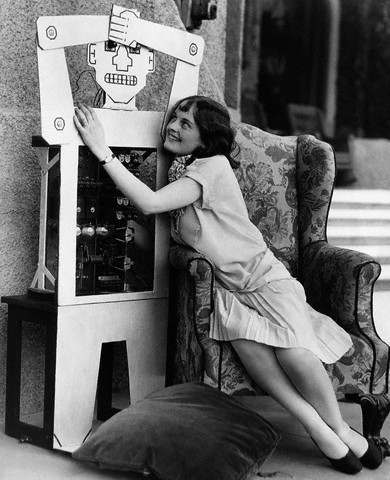
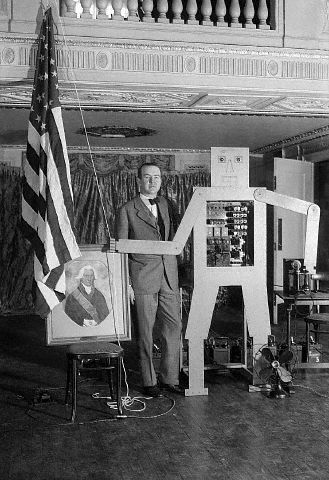

"Herbert" Televox by Roy James Wensley (1927), Westinghouse Electric and Manufacturing Company, Pittsburgh. Televox is not actually a mobile robot, as you may have already guessed from the photos, but a sophisticated smarthome automation system. You phone home in the usual way and then use tuned pitch pipes or electric tuning forks to sound different tones down the line. Televox uses different tone sequences to switch different items of equipment on and off. Televox can also provide audio responses to tell you the status of home sensors, so it can tell you if your heating is up to temperature. Televox was housed in a large upright box, with a small box on top, which looks a little bit like a body with a head; so on 23 Oct 1927, the New York Times ran an article with a robot-like cartoon of these boxes, as a way to explain the capabilities of Televox, because the Internet of Things hadn't been invented yet. The version we see with the cut-out human form (with Wensley to the left) was made for George Washington's birthday, on 22nd Feb 1928, and Westinghouse marketing loved it so much that a number of 'humanoid' Televox units were demoed across the country. If you look closely, you can almost see Wensley dying inside.
31 notes
·
View notes
Photo


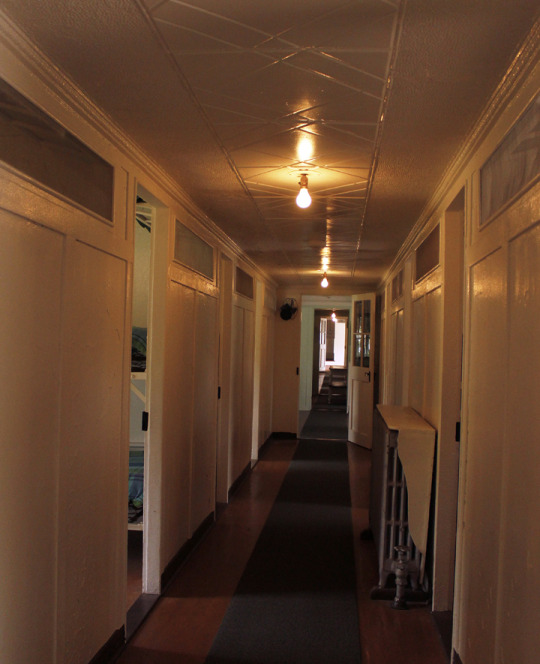
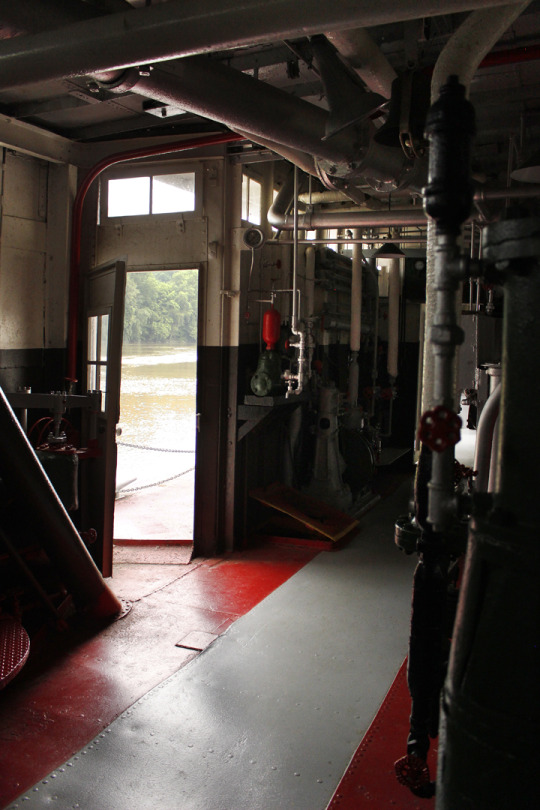

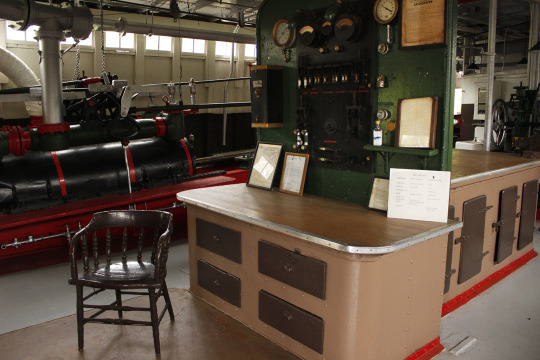
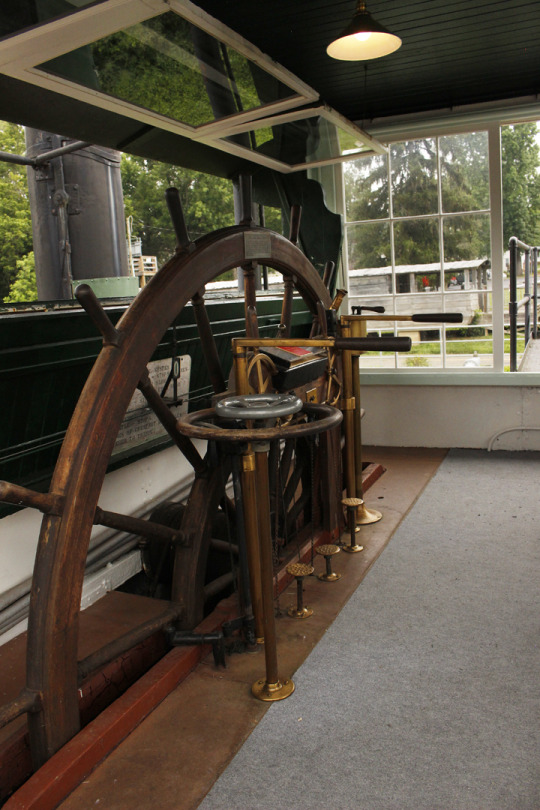
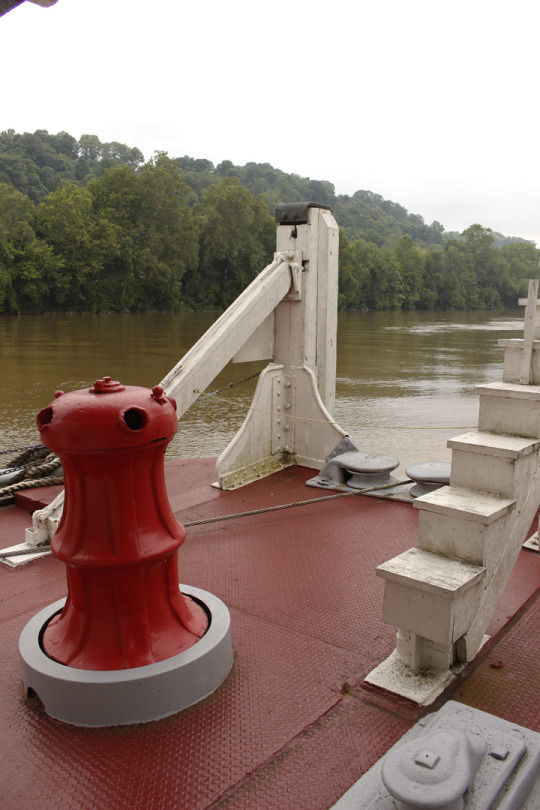
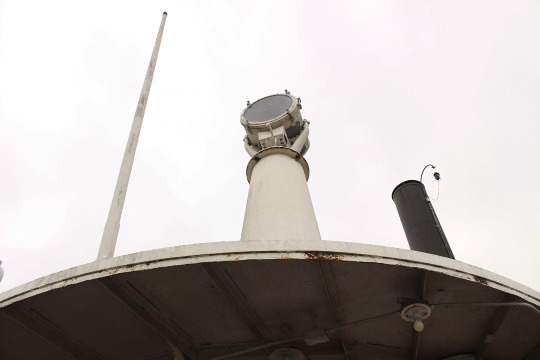
A Visit to the Ohio River Museum’s W.P. Snyder, Jr., Marietta, Ohio.
“Hey, Atlas Obscura, I’m heading south-east through Ohio toward West Virginia; what can I stop and look at along the way?”
Or some such thought was in mind as I “prepared” to drive off to Thurmond, WV, for another visit to that “ghost town” in the New River Gorge. There were a few places that I considered, but they were well off that north-west-to-south-east track that I wanted (too far to the north-east or south-west). Also well off of U.S. 35 that I would be traveling but still in the right direction was the Ohio River Museum, in Marietta, OH, and it’s major holding, the steam-powered towboat W.P. Snyder, Jr. It was the boat that got my attention.
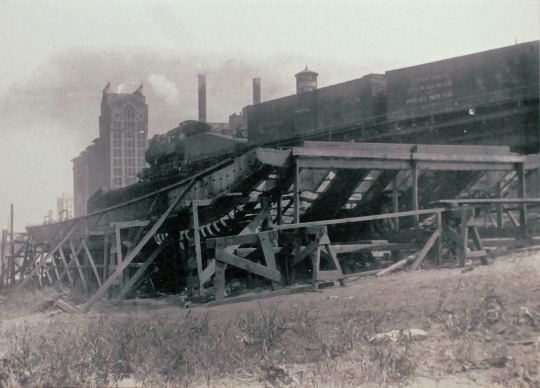
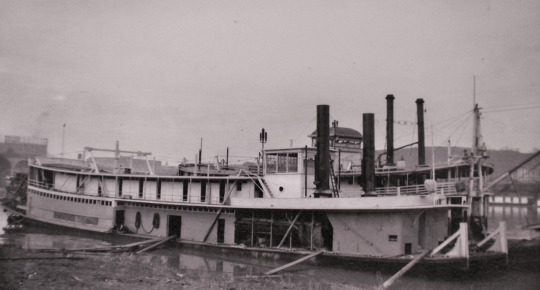
Two views of the steamer under construction in Pittsburgh. [1]
Built for Carnegie Steel, it was delivered in 1918 for barge work on the Monongahela and Ohio rivers as the W.H. Clingerman, in which service it operated until 1945, when the Crucible Steel Co. bought it; it was then renamed after that company’s chairman.
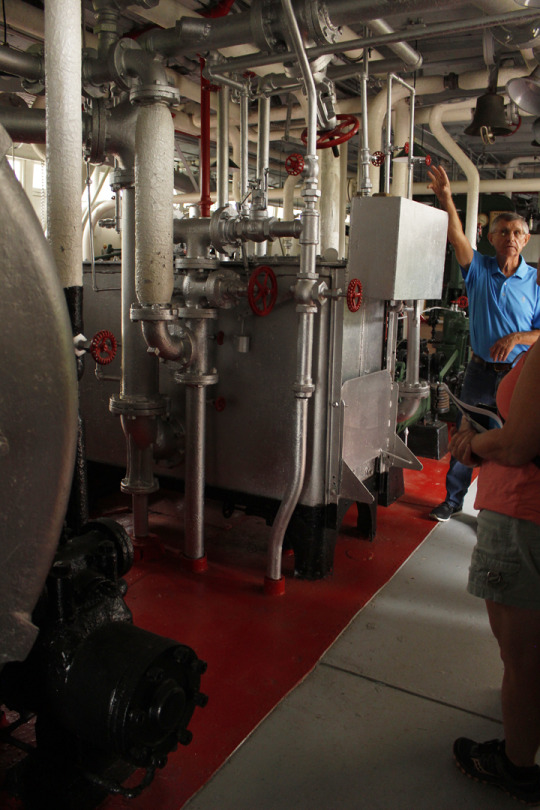
Alan, one of the museum’s volunteer tour leaders, indicating salient parts in the engineering room.
The Ohio, Allegheny, and Monongahela Rivers all have a number of lock-and-dam constructions up and down their lengths through the old-line industrial region, which create “pools” to aid navigation and to alleviate flooding (when possible). The boats built to work the rivers were constructed especially to fit within the locks, had their pilot houses situated at the fore-end of the boiler deck (to allow passage under low bridges), and were called “pool boats.” The Snyder was one of hundreds built to service the coal and steel businesses during the hey-day of “Big Steel,” but is today the last, still-floating, steam-fired, stern-wheeled pool boat. Sadly, it’s not likely to ever pull off the riverbank under its own power again (I asked).
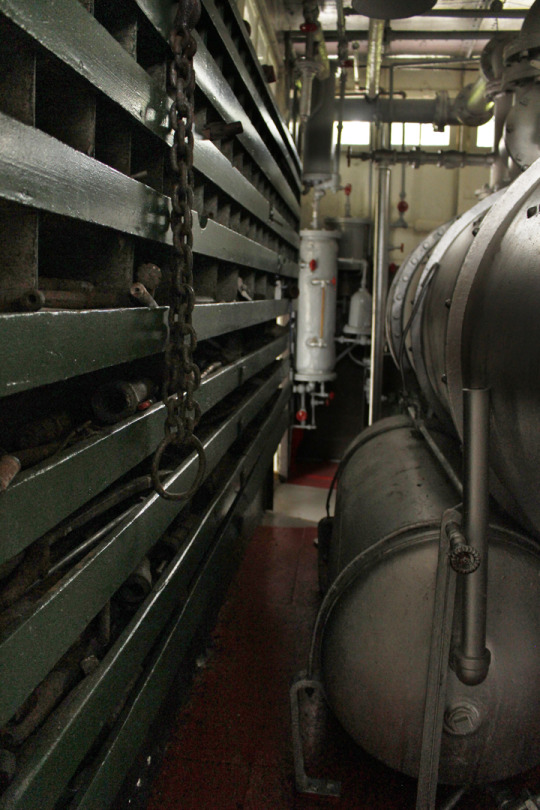
Parts bins and condensers at the forward bulkhead in the engineering room.
The Snyder (or Clingerman) was state-of-the-art for 1918: it had electric lighting, power aided-steering, a full kitchen (with walk-in refrigerator!), a shower for the crew, a bathtub for the maid (yes, a woman), a full laundry, and featured automated “fuel augers” to shove coal into the boiler fire boxes. Alan, our tour leader, told us that it was actually fairly common by the early 20th century for there to be a woman working as a maid, and not uncommon for her to be wife to one of the higher-rated crew, like the chief engineer.
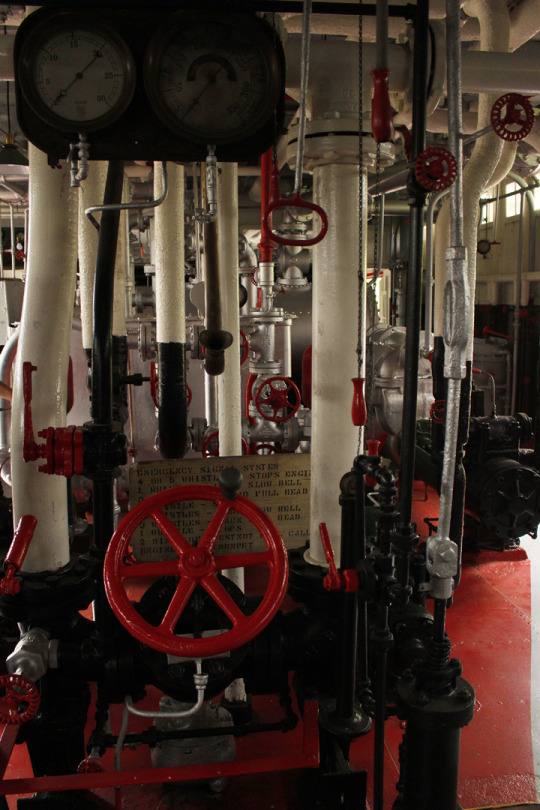
Looking forward through the maze of piping in engineering.
The steam powered pool boats were put out of work by newer, diesel powered boats that were being launched in the late 1930 and in the ‘50s. Needing smaller crews and less maintenance (much like the difference between steam locomotives and diesels on rail roads) the steamers were retired and scrapped. The Snyder was retired in ‘54, but someone had the bright idea to save it; it was moved to Marietta in ‘55 and permanently moored.

Typical double-bunk crew room. Doors to both the central passageway and to the outside were included to make escape easier in case of fire. The Snyder has enough double-bunk rooms to allow each crewman to have his own bed instead of sleeping in a “hot sheet” arrangement. The maid had her own bunk room and wash room.
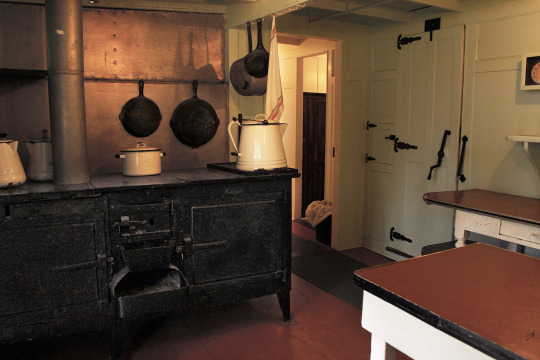
Galley (kitchen) with a very large coffee pot on the coal stove; the walk-in cooler or refrigerator is to the right-back, with the heavy hinges and pivot lock that were features of the (much smaller) in-home ice boxes of the era.
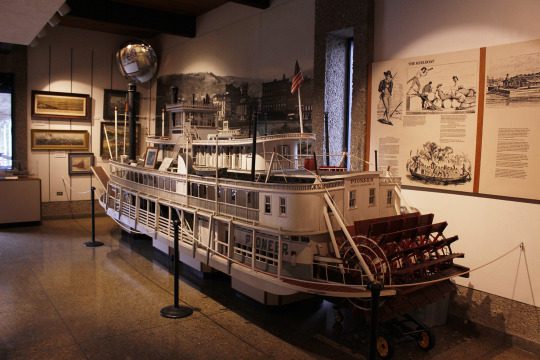
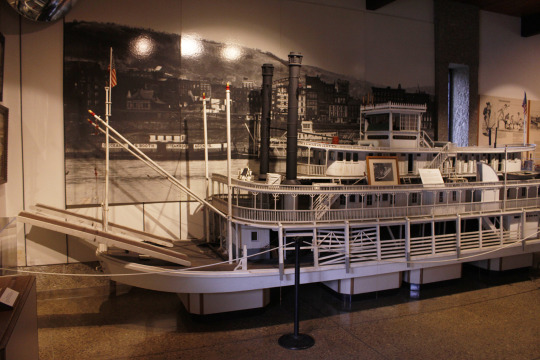
Contrasting details: though only a (very large) model, this packet boat inside the museum shows the kind of steam boat that would be typical of the Mississippi River’s steam boating era, and an example of the steamer commonly held in popular imagination. [2] Rivers steamers were considerably longer and higher in profile than pool boats, and carried cargo and passengers, while pool boats just did the barge work.
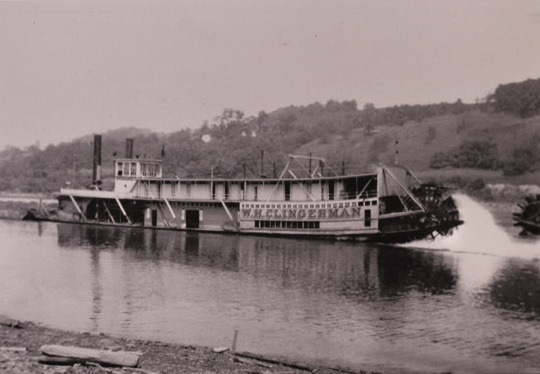
The Clingerman under way in 1930. [1]
Photos: R. Jake Wood, 2021 except as noted.
Ohio River Museum
Atlas Obscura
[1] Photos as displayed in the Museum; no specific attribution; minor processing for perspective and exposure by Jake Wood.
[2] Steamboat model Pioneer built by George Schotten, circa 1970; a fully detailed, if reduced scale, boat, the Pioneer was capable of being floated and piloted in a river.
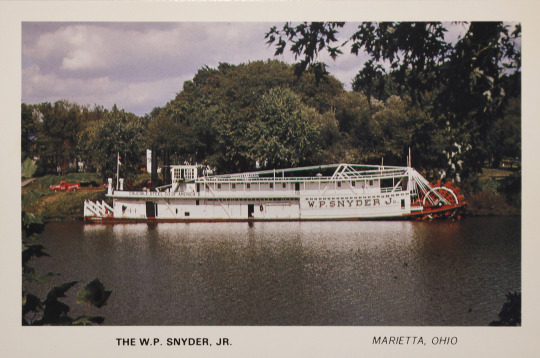
Postcard shot! Literally, a picture postcard of the Snyder by S. Durward Hoag.
1 note
·
View note
Text
Synergies Between Home Automation and Security Systems
How can convenience and peace of mind be guaranteed through the seamless integration of home automation and home security systems? Our homes are becoming smarter in today's rapidly changing world, offering a variety of interconnected technologies that improve our comfort, convenience, and security.
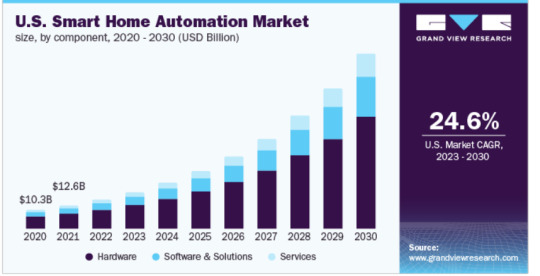
(Source: https://www.grandviewresearch.com/industry-analysis/smart-home-automation-market)
As homeowners in the US increasingly seek comprehensive protection while enjoying the benefits of automated living, the potential synergies between security and home automation in Pittsburgh become an intriguing topic of exploration.
Exploring The Overlapping Domains: Where Automation Meets Security
In today's world, the merging of home automation and security systems opens up exciting possibilities. With the use of advanced technologies like facial recognition and biometric authentication, security systems have become smarter and more efficient in protecting our homes.
The convergence of automation and security creates a synergy that benefits homeowners in several ways:
Enhanced Security Measures
Integration of security cameras with automation enables real-time monitoring and remote access to video feeds.
Motion sensors integrated with automation can trigger alerts, activate lighting, or adjust temperature settings in response to detected activity.
Smart locks and access control systems can be seamlessly integrated with automation, allowing convenient and secure entry.
Automated Responses
Automation systems can be programmed to respond to specific security events automatically, such as locking doors, activating alarms, or notifying authorities.
In case of emergencies like fire or gas leaks, automation can trigger immediate actions, such as turning off appliances and notifying homeowners.
Peace of Mind
The ability to remotely monitor security cameras and receive real-time alerts through automation provides homeowners with peace of mind even when they are away.
Integration of automation and security systems allows homeowners to create custom scenarios, such as simulating occupancy when on vacation, enhancing the perception of a secure and inhabited home.
Importance Of Consulting A Professional For Home Automation
Consulting a professional for home automation is essential to ensure a smooth and effective implementation. Here's why it's important:
A professional surveillance camera installer possesses the technical knowledge and experience to install, integrate, and configure automation systems correctly, maximizing their performance.
Experts in the field can assess your unique requirements and recommend tailored automation solutions that suit your lifestyle, preferences, and budget.
Best service providers understand how to integrate different automation components seamlessly, ensuring compatibility and a cohesive user experience.
Most professionals offer ongoing support, troubleshooting, and assistance, ensuring your automation system functions optimally and addressing any issues promptly.
A professional security camera installer prioritizes the safety and security of your home, implementing robust protocols to protect your privacy and safeguard against potential vulnerabilities.
Final Words
By consulting a professional for home automation, you can benefit from their expertise, ensuring a reliable and efficient automation system that enhances your daily life while providing peace of mind.
Now, are you looking for a network cabling installation service or an ethernet cable installer in Pittsburgh for home automation with reliable network infrastructure? Look no further than Red Spark Technology. With competitive prices and a team of experts, they have got you covered. Reach out to the professionals at Red Spark Technology today for more information!
Source: https://redsparktechnology.wordpress.com/2023/07/31/synergies-between-home-automation-and-security-systems/
0 notes
Text
Akeptus
Address: Pittsburgh, PA 16046
Phone: 202-991-1826
Website: https://www.akeptus.com
Business email: [email protected]
Akeptus is your partner for change. We use the power of Artificial Intelligence (AI) to help you lower your monthly bills and protect the planet through lower carbon emissions. Our affordable and easy-to-use smart system allows you to control your lighting, water, heat and cooling usage while it learns what your most comfortable settings are.
Keywords: smart cities, smart home automation, home automation, automation for homes, smart building, clean tech, smart thermostat, smart lights
Hours: Mon - Fri: 8 am - 5 pm, Sat: 8 am - 1pm
Facebook: https://www.facebook.com/akeptus
Twitter: https://twitter.com/akeptus
Instagram: https://www.instagram.com/akeptus/
Linked-in: https://www.linkedin.com/company/akeptus
1 note
·
View note
Note
Hi!!! Are there any upcoming fics you’re planning and if so I’d love to hear about them 💕🍀
Oh goodness! This is a great question. My WIP list is really long since I write pretty slowly (or really, I write pretty fast when I actually do it, but tend to spend more time editing or daydreaming about writing then writing). But these are the ones I think I will actually finish:
1. Probably the next thing I will finish is a Klaus & Lemony thing to kind of go with the Violet & Lemony and Sunny & Lemony thing. It’s about half written and focuses on how they are super awkward together. I don’t know why, but that’s what worked. It’s also about Lemony spying on the Baudelaire’s, what Klaus thinks of Lemony’s books, and Lemony giving Klaus the pictures of him and Beatrice and Bertrand from Lemony and Beatrice’s engagement party. But it may be about something else by the time it’s done. I’ve changed my mind about this fic so many of times already.
2. I really want to write Lemony and Moxie getting back together (as friends--I don’t think there is really a phrase for that) after not talking for at least a decade after atwq. Just based on how that ended, Moxie needs to do a lot of soul searching, and things would need to change quite a bit before she wanted to pick that friendship back up. I think Lemony really hurt her. I have like.. two paragraphs written.
3. Based on a misremembering of what happens in TSS, I started writing fic about Lemony and Olaf meeting up in the hinterlands while Olaf went to get the lions. I actually have a lot of this written; parts of it really don’t work, but I am determined I will make it work eventually.
4. Disastrously long and meandering Lemonberryice sick fic. Lemony gets ill and the Baudelaire parents hide him in their bedroom for a week. It was supposed to be something of a lark, but with me and my need for canon compliance, it accidentally got real sad and focuses mostly on them failing to deal with any of their collective issues. I wrote the beginning and the end, and I accidentally put them way too far apart, so it’s going to take me a really long time.
5. This one is from my previous fandom, but it’s like 7000 words long (I’ve gotten so far I can’t give up on finishing it): Twin Peaks fic laying out in horrible depressing detail my head-canon for what happened in Pittsburgh. It’s almost as much about my adopted home city as it is about Cooper and Caroline.
(And then there is the SAFe!AU that I am not going to write, but spend a lot of time daydreaming about, because I have a whole wardrobe planned for software dev!Beatrice, and I have lots of fun fantasizing about Bertrand doing my job (I do test automation), and Lemony as a Scrum Master and technical writer is endlessly funny to me. The real schism is agile vs waterfall.
5 notes
·
View notes
Text
A Zero Waste Wedding in Pittsburgh
If you have been on Facebook lately, you have probably seen videos of turtles tangled in plastic, birds whose stomachs are full of plastic, and reports about Global Warming.
Whether your political inclinations deny or are against global warming, the truth is, our planet is polluted, and right now, you are either part of the solution or part of the problem, there is no middle ground.
But the problem is that when it comes to bringing environmentalist values to wedding planning, if you are not in California, or don’t have a 6 digit budget, it becomes a little hard, and you might end up giving up for the sake of the circumstances.
So I want to show you, where you should be focusing your energy and resources, but first, let me introduce you to the “Buyerarchy of needs” which will be inspiring our whole journey, and I hope you look at this, read it, meditate on it, and then apply it.
1: Focus on the things that don’t cost you anything, pick a vibe, a feeling as the guidance for your wedding day.
If you look around for wedding day inspiration, everything is based on color palettes, flowers, or decor. However, since we are trying to be intentional and not use as many material things during the wedding day, it is better to base your inspiration on intangible things rather than material things, instead choose to get inspired by feelings, or the vibe you want your wedding to have. For example, the vibe for the image below was: contemporary, artsy, and fresh.
2: Focus on finding the core vendors for your wedding
(Yes, before setting up a date or even the location). Once you pick the vibe, you will need to gather the elements that will bring your vision together. But Unless you are working with the proper people, translating a concept to reality within a budget, can be hard. So, before even selecting the date for your event or the location, we highly encourage you to select the group of humans that will bring this to life. The core vendors are: Wedding Planner Venue Caterer Officiant Photographer Since the “ethical” journey begins before the wedding day itself, when reaching out to vendors, ask them upfront about what environmental practices they have in place.
Asking this up front will set the tone for the rest of the planning process, and if this is something that is not present in their practices, your question will surely push them in the right direction.
3: Where and When?:
Choose the date and the venue.
Whether you decide to marry at home, or in a big space, there are some things that you need to take into consideration, such as accessibility for your guest, location of your party hub, weather, and of course, environmental practices.
If you go for the most popular choice, a venue, ask them and yourself the following questions:
Does your venue send all the garbage to a landfill, or does it have any recycling practices in place? Do they offer furniture, or do you have to rent these items separately? Does the venue have decorative elements, or is it a plain room that needs a lot of stuff to look good? Does it offer in house booze/catering, or can you bring your own?
So many questions, right?
From the low waste perspective, it is a priority to choose a space that offers dishes, cups, and straws that are not plastic.
(I doubt you want a turtle in the Caribbean to swim among the straws from your wedding day, right? … #justsayin)
4: Let’s tell the world: The stationery (Oh poop! When things get real)
Although an online invitation is often times more eco-friendly, in practice, not everybody is a fan of receiving an email, and being inclusive of older generations who are less e-literate, is a good way to honor them. So when it comes to papers, what alternatives are low waste?
The invitation is the first thing your guests see, it sets the mood for the day, it tells your guests whether joining is going to be worth it, and it announces what kind of party this is going to be. Once the invitations are sent, things get real, and telling your guest that this is an environmentally friendly kinda day deserves to be announced in an environmentally conscious way. Here is where the value of a designer that can custom work for you is a thousand times better than printing some DIY, but make sure the designer is open to working with eco-friendly papers.
Have you heard about paper made out of elephant poop?
When it comes to being low waste, there is nothing better than options that ethically made, creative, and contribute to giving opportunities to economically and socially marginalized groups. So do your research in regards to papers, and if you are feeling like DIYing, you can DIY the envelopes from the newspapers at your grandma’s house.
PS: Oh! And forget about RSVPs! Nowadays everybody texts, so you can use an automated text message RSVP service which is the easiest way to gather replies from your guests, and automatically organizes and counts for you. SCORE!
(If you never saw paper made of poop, now you did | Stationary by the kick ass: Fresh Cut Prints )
5. Creating a wedding atmosphere: Decorations
One of the things about low waste, is that sometimes it might be a little on the plain side, so for a wedding, which we want to look special, we really have to put thought into what we bring in.
Using what we have, or what you can realistically keep afterward is key. So, first, my biggest and probably most overlooked decoration element that is also functional is: LIGHTS!!! I’m not talking about regular light bulbs, but lighting can make an amazing decoration, which afterward leaves zero trace.
Another suggestion is to use real plants as a decorative item. Not only they will give you a decoration the day of your wedding, but will decorate your house for the years to come, and imagine having the same plants that witnessed you saying “I do”, witnessing your anniversary year after year!
"Did you know that glass can be recycled forever and ever?" -- FUN FACT
Another element that is overlooked but it is quite easy to make, and to compost afterward is dry flowers. You can actually invest time in planting your own and meticulously dry. Finally, for any other need, hit your local thrift store! You would be surprised to see the amounts of linen available there.
Oh! And also… keep an eye on the dumpster! Someone else’s garbage always has the potential to be your treasure.
5. Time to get pretty
An element of your wedding that takes a lot of mental energy, a big chunk of your money, and it makes a massive statement in regards to the environment is fashion. And if you want to make a statement, the options for your outfit are: Ethically sourced. Wear your own. Make your own outfit. Or Vintage. This groom decided to wear his own clothes, and the bride opted for the vintage.
The statement piece for the bride was her earrings, which were upcycled. Altogether their outfits were around $30, which allowed more $$ to be allocated for other services.
As you can see, going this route is a great way to maximize your budget, but if you feel uncomfortable with the idea of wearing a vintage style of clothing, you can always purchase vintage garments and budget for the services of a seamstress that can transform your vintage piece and gives it a modern twist.
6. Beauty
I have to be the first in recognizing that zero/low waste and the beauty industry are not the best of friends. Beauty is perhaps one of the most forgotten subjects when it comes to thinking low waste wedding, maybe, because it is not you using that bottle of shampoo that will end up in a landfill, you don’t think much about it. Nowadays there are many makeup products companies using cruelty-free and vegan options (yay). But I learned from Becky, owner of the hair salon that does my hair, Tula Organics, that certain brands go to the extent of manufacturing products with 100% wind power, and they purchase carbon offset credits to balance any climate impact of their aerosol hairsprays.
She also told me about Dragon Master Foundation, a charity organization fighting to find a cure for cancer, and to whom you can send personal care and beauty containers to be recycled. This is an amazing initiative, to make the world greener and fight cancer at the same time.!
In summary:
A low impact, environmentally wedding is not unrealistic. Even if you don’t live in California, it is totally possible right here in Pittsburgh, and even with a small budget. All you might need, is to think through and plan with time, along with a good group of ethically minded wedding vendors.
Supporting Cast: Planner & Aesthetic designer: Devoted To You Events @devotedtoyouevents Florals: greenSinner @greensinner HMUA: Tula Organic @tulaorganic Venue: Kingfly Spirits @kingflyspirits Lightning: EF Lighting @eflighting Plants + Greenery: City Grows @citygrows Photographer: Sandrachile @sandrachilep Invitation Fresh Cut Prints @freshcutprints Paper Mr Ellie Pooh @mr.elliepooh Cake: Mediterra Cake House @mediterracakehouse Jewelry/Accessories Adaptive Reuse @christineterrell Calligrapher- Scarlet Day Calligraphy @scarletdaycalligraphy
#zero waste wedding#zero waste weddings#plastic free wedding pittsburgh#plastic free wedding#eco friendly wedding#ecosustainable photography#pittsburgh eco friendly wedding#vintage wedding dress#Sandrachile#Sandrachile Photographer#wedding pittsburgh#pittsburgh wedding photographer#photography wedding pittsburgh#squirrel hill weddings#hipster couple pictures pittsburgh#hipster wedding
2 notes
·
View notes
Text
It’s the Economies, Stupid
John B. Judis, Washington Post Magazine, November 29, 2018
The evening of Tuesday, Nov. 6, brought the latest visual manifestation of our highly divided country: the 2018 midterm elections map. The map was similar to previous election maps--blue on the coasts and, across the rest of the country, wide swaths of red interrupted by blue dots. The major change was in the size of those blue dots: Increasingly, they seemed to be composed of both large cities and the suburbs that surround them. But why?
For two years, the main analytical lens for explaining the unshakable red-blue division in American politics has been culture and ideology: Fox News vs. MSNBC. Gun owners vs. gun skeptics. Colin Kaepernick detractors vs. Colin Kaepernick supporters. “How Everything Became the Culture War” read one recent headline in Politico Magazine. And on the surface, the 2018 midterm elections did indeed appear to boil down to cultural issues: the approach of a caravan of Honduran migrants; the rival narratives of Brett Kavanaugh and Christine Blasey Ford; and perhaps most of all, the political style of President Trump, which Democrats view as exceedingly offensive and many Republicans have come to see as acceptable or even admirable.
Yet in that map--and in those expanding blue dots--was a clue to another lens, one that often gets short shrift in explaining the fracturing of our country. That lens is economics--specifically, jobs. Red and blue America aren’t separated just by their cultural politics; they are separated by sharp differences in how their economies have developed over the past half-century. And those economic differences can, in turn, explain many of the cultural differences that so bedevil our political system.
There are, of course, a number of different sectors of the American economy, and those sectors can have varying kinds of political influence on the people who work in them. But it’s the changing dynamics of two particular sectors--the older industrial economy and the newer ideas economy--that explain how the current U.S. electoral map came to be. Which is why, here in Washington, if we want to formulate policies that might begin to heal our democracy, we need to pay attention not just to ideology and culture, but also to what those blue dots are telling us about where and whether people go to work each day.
Over the past 50 years, America’s industrial economy--based in the production of steel, ships, cars, textiles and other goods that were often made by factory workers on assembly lines, plus the service jobs that flourished around them--has declined substantially. Many of the older industrial sectors have become automated; they produce more with fewer workers. Other industries have moved abroad to lower their costs or have closed down in the face of foreign competition, particularly, over the past 15 years, from China. Between 1979 and today, the number of manufacturing jobs has plummeted from 19.4 million to 12.7 million.
The older industrial economy was based in cities and towns--Midwestern locales like Chicago, Gary, Detroit, Muncie, Akron, Allentown and Pittsburgh; and Southern towns like Mobile and Greensboro. The blue-collar workers tended to live in the cities, and the white-collar office workers and managers in the suburbs. As the older industries have fallen into disrepair or moved, some of the towns and cities have fallen on hard economic times. Many residents have moved to nearby suburbs; their children, if they were able to, left as soon as they finished school.
Alongside the decline of this old economy, a new, knowledge-based economy has arisen. This economy specializes in ideas--embodied in such goods as pharmaceuticals, semiconductors, movies and software. MIT economist Peter Temin has dubbed this sector “FTE”: finance, technology and electronics. In recent years, metropolitan areas identified with FTE have prospered and expanded outward. Some of the FTE areas, like Chicago, Los Angeles and Seattle, are former centers of goods production that have managed to reinvent themselves; others, like Austin and Northern Virginia, are places where the economy was long rooted in government and education. In all of these areas, the older distinction between the city, where production takes place, and the suburbs, where the white-collar workers live, has broken down. Microsoft is a Seattle company, but it is located in a suburb. New Jersey’s pharmaceutical industry is suburban, and much of New Jersey itself is a contiguous suburban metro area.
Metropolitan areas that specialize in a new, knowledge-based economy have prospered and expanded outward. These areas often have one or more major universities. They host a high percentage of college-educated workers (frequently with advanced degrees), some of whom are highly skilled immigrants. They also include a sizable class of service workers, who are often immigrants and who clean the buildings, mow the lawns, make the beds, drive the taxis and take care of the children of two-earner families. Some of these areas, like Chicago and Los Angeles, include older, low-income, mostly African American inner-city neighborhoods; but African Americans have also increasingly moved into middle-class suburbs like those of Prince George’s County outside Washington, D.C. In fact, from 2010 to 2014, the African American population in the suburbs of the 20 largest metro areas grew by 7.1 percent, while the urban population grew by a bare 0.1 percent.
The regions built around FTE are almost always geographically distinct from the old industrial areas and from areas dominated by agriculture or resource extraction. The separation of the regions has proved to be self-reinforcing, as new high-tech firms seek to be near other high-tech firms and in areas where there are major universities and a high percentage of college-educated workers. In “The New Geography of Jobs,” economist Enrico Moretti has described this process as “geographical agglomeration.”
If you want to see geographical agglomeration in action, look no further than the now-concluded battle over where Amazon.com would locate its next headquarters. The finalists included FTE locations like Austin, Chicago, Atlanta, Los Angeles, Philadelphia, Boston and Denver; the winners--New York and the D.C. metro area--are two of the most FTE-friendly places in the country.
These geographically separate economies have produced very different ways of living--and, crucially, very different personal identities. Identity--the result of imagining ourselves as part of a larger group or cause--invariably plays an essential role in all of our lives.
Many Americans (primarily but not all white) who once lived comfortably in older Midwestern and Southern towns have had important parts of their identity stripped away by the transformation of the U.S. economy. Many of them once enjoyed lifetime employment from the same company and could identify with that company--whether it was General Motors or Sears. They also may have enjoyed the protection and solidarity of belonging to a union. They lived in neighborhoods and frequented the same bars, restaurants, churches and bowling alleys. They and their friends had gone to the same high schools and followed the same local teams. They owned their homes and protected them by owning guns. Many of the men had served in the armed forces and belonged to veterans’ groups.
Move ahead to now: The company has left. The union is gone. The neighborhood is gone. Many of the working-class whites, like the Trump supporters in Ohio I interviewed for my last book, have moved to nearby suburbs, where the main public square is the shopping mall. As identities made possible by the old jobs and the old economy have faded, other identities--ones often associated with hard-line conservative politics--have both endured and filled the void: strong identification with the traditional family, with the home (for which these voters see gun ownership as an essential means of protection), with church and religion, with the flag and the nation. Interwoven among these identities are ones that are fundamentally rooted in resentment: toward undocumented immigrants whom they believe their taxes subsidize; toward both legal and undocumented immigrants who they see as upending the mores and language of their hometowns; toward those minorities who, in their minds, benefit unfairly from affirmative action; and toward distant elites in the cities who project disdain for them and their way of life.
These Americans formed much of the political base for the religious right of the 1980s and ‘90s, the gun rights movement, the anti-immigrant movement and the tea party movement. They now provide the most fervent backing for Trump’s presidency. His electoral college majority in 2016 was based on their support in states like Ohio, Pennsylvania and North Carolina, together with more traditional Republican support from small and big business and from states like North Dakota and Oklahoma, which are dominated by agriculture and resource extraction.
In the FTE areas, the situation could not be more different. Whereas the people who still live in industrial America have had many of their identities stripped away by the decimation of the old economy, the residents of new metropolitan centers suffer if anything from a surfeit of fluid identities. They celebrate Thanksgiving and would defend the United States if it were attacked, but Trump’s slogan, “Make America Great Again,” has little meaning for them. They don’t look back upon a golden age of GM and Sears and the neighborhood pub. They identify as family members or parents, but their conception of family has been significantly broadened by the feminist and sexual revolutions that began in the 1960s.
They may have fond memories of the places where they grew up, but many take more pride in the university they attended. (When I first came to Washington in 1982, I used to amuse myself by privately speculating how long it would take for a downtown hotshot to tell me what university--invariably Ivy League--he had graduated from.) They often belong to professional associations. They derive their identities in part from the products they produce--software, articles, movies--and from the prestigious firms where they work. They are more likely to be part of experimental families, more likely to be gay or have gay friends, more likely to agitate for LGBTQIA rights. They don’t think of themselves as tied to one city. They save their money to travel. They identify as Americans, but also as cosmopolitans. They recoil at Trump calling himself a “nationalist.” They see his supporters as ill-educated bigots, and they see themselves as part of a new global network linked by the Internet.
True, these are sweeping characterizations, and not everyone who lives in FTE areas adheres to them. For one thing, not everyone writes code for a start-up or has graduated from college; invariably, these areas have sizable low- or mid-wage service industries. Yet it is reasonable to assume that those FTE residents who work in service are not immune to the broader values and outlook of the economy that surrounds them. As I told my daughter when she moved to the Bay Area a decade ago, people there won’t want to know what job you have; they’ll want to know what you are “into.” The barista may also be an aspiring actor; the Uber driver (as one in Houston informed me) makes rap videos; the landscaper may have built (as ours did) a political website.
The Democrats’ electoral college majorities in the Barack Obama years and their popular majority in 2016 were powered, in part, by the multiethnic and multiracial members of this urban-suburban FTE economy and culture. Their growing ranks offered a powerful (and overlapping) supplement to the ranks of minority voters who--even when they do not live in FTE areas--have long placed, and continue to place, their faith in the Democrats as the party of civil rights, and of government assistance for those in need.
This electoral coalition is, of course, far from stable, but it persists and grows because of common opposition to what the Trump coalition stands for. And like the Republican coalition, it is at least partly explained by the kinds of jobs that exist in the places where many of these voters live.
As the metropolitan areas grow and expand at the expense of older industrial towns and rural areas, they will--barring gerrymandering--make it easier for Democrats to maintain the House and also to win popular majorities in presidential elections. At the same time, Republicans may be able to maintain control of the Senate, where a relatively unpopulated state with no large new-economy metropolitan area can send the same number of representatives to Capitol Hill as California or Virginia. In this election, Democrats easily carried the House but lost Senate seats in Missouri, North Dakota and Indiana, three states that have few, or any, FTE metro areas. In other words, a split Congress--with all the gridlock that suggests--may become the norm in American politics.
The divisions between the two economies also make more likely the prospect of the electoral college--which tilts in favor of less populated states that are not dominated by metropolitan areas--failing to reflect the will of a majority of voters. That, in turn, may raise questions about the legitimacy of our presidential elections. Results like 2000 and 2016, when Republicans lost the popular vote but won the presidency, could become increasingly common.
Perhaps the most troubling--and thorny--upshot of these changes is that they have given rise to the latest culture wars, which in turn serve to distract us from addressing the economic issues that have caused so many of our divisions in the first place. Trump, to his credit, seems to have geared his trade policy toward reviving manufacturing in the forgotten regions of middle America. But whatever benefit Americans may get from Trump’s trade policies--and it’s still not clear there will be any--is certain to be outweighed by his never-ending attempts to inflame cultural divisions by inciting nativist fears and racial hatred.
It’s hard to imagine America finally confronting the differences in prosperity and prospects between red and blue areas as long as Trump and his tweets occupy center stage, transfixing Democrats and Republicans alike. Yet for the sake of America’s future, we are going to have to find a way to talk honestly about the massive divide caused by the two economies--and somehow, start working to bridge it.
John B. Judis is the author of “The Nationalist Revival: Trade, Immigration, and the Revolt Against Globalization.”
1 note
·
View note
Text
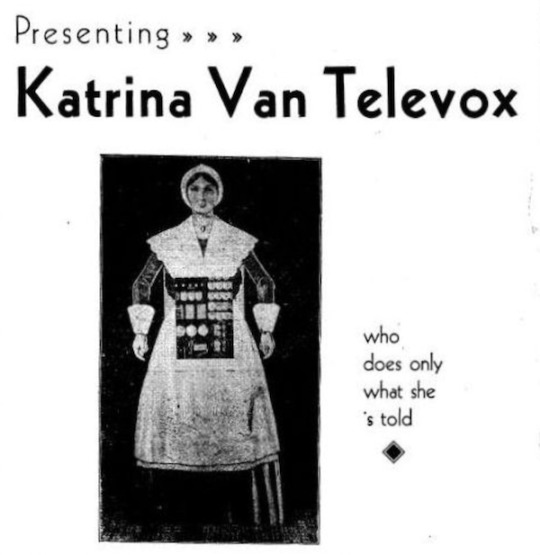
Katrina Van Televox by Roy James Wensley (1930), Westinghouse Electric and Manufacturing Company, Pittsburgh. In another marketing master-stroke, Westinghouse produce the next version of their smart automation system in the form of a "Mechanical Wonder Maiden ... who does only what she's told." Katrina differs from Herbert Televox in that 'she' provides spoken feedback using sound tapes, rather than beeps and whistles. "The Westinghouse $22,000 Robot Servant invites you to her Housework Demonstration. Katrina talks… answers the phone… runs a vacuum cleaner… makes coffee and toast… turns the lights on and off and does it all willingly at command from Mr. T. Barnard the Westinghouse Electric & Manufacturing Expert who is accompanying her on her tour." Miss Van Televox would set you back a hefty $390,303 at 2022 prices, so isn't really targeted at home users, but company executives.
22 notes
·
View notes
Text
How Technology Services and Solutions in Pittsburgh Can Transform Your Business

Take a moment out of your busy schedule and look around. You will see technology in every nook and corner. From the smartphone in your hand and the wristwatch on your wrist to the intangible internet all around you, and coffee makers you use, tech-based advancements are everywhere. Yes, you don’t need all things high-tech in your home or office, but if you want to thrive in the fast-paced business landscape in Pittsburgh, Pennsylvania, hiring professionals for technology services and solutions in Pittsburghis imperative. Why? Well, here are all the transformative possibilities businesses of all sizes can avail with low voltage cabling and technology specialists.
#1 Data Cabling Installation
(The Foundation for Connectivity)
For any business infrastructure, data cabling installation is the foundation of moving towards smart technology. Having a rock-solid cabling network ensures businesses can have a seamless communication system in place, and data transfer across all devices is as smooth as it gets. In addition, enterprises can also benefit from state-of-the-art data cabling solutions customized according to their specific needs.
Professional data cabling installers in Pittsburgh use industry best practices to design and implement structured cabling systems that support current technology requirements while allowing future scalability. Whether we are talking about Ethernet cabling, fibre optic or installing AV systems they can lay the groundwork for smooth operation with data cabling installation.
#2 Security Camera Installation
(Technology for Safeguarding Your Assets)
In today’s business environment, security has become more important than ever, and investing in surveillance technology can be a proactive measure to safeguard your assets and ensure a secure work environment. Security camera installers in Pittsburghcan deploy comprehensive video surveillance systems according to your business demands, and that too within a budget. From HD cameras with remote monitoring capabilities to standard surveillance solutions, professional installers can offer you a wide array of solutions and ensure all the cameras are placed strategically with user-friendly access control systems. Businesses can leverage these surveillance systems and deter unauthorized access, mitigate risks and safeguard valuable resources.
#3 Home Automation
(Enhancing Comfort and Convenience in the Workplace)
Home automation in Pittsburghisn’t just limited to residential spaces; it extends way beyond that. In an increasingly interconnected world, the concept of automation can be a great idea to enhance energy efficiency, streamline facility management, and create more comfortable workspaces for employees.
From automated lighting and climate control to integrated audio-visual systems and remote access capabilities, home automation solutions in Pittsburgh offer a seamless blend of convenience, efficiency, and sustainability. Businesses can always switch to technology and automate routine tasks to optimize resource utilization, reduce operational costs, improve productivity and create an enjoyable work environment.
Conclusion
Nowadays, businesses are becoming smarter. Whether we are talking about audio-visual installation and integration, IT and Wi-Fi installation, surveillance, data cabling, Ethernet connection, or something else, embracing technology in all facets of business has become the new normal. Are you looking for technology experts in Pittsburgh for data cabling installationor something else? Contact the team at Red Spark Technology today!
Source: https://redsparktechnology.blogspot.com/2024/03/how-technology-services-and-solutions.html
0 notes